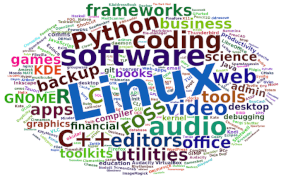Last Updated on May 13, 2021
This is a series of articles about buying a refurbished mini PC to run Linux as a desktop machine. Along the way, we’ll explain what you really need.
Most of the acceleration toward super-small in desktop PCs has happened over the last decade. Naturally, there are many business machines running today in bulky power tower cases containing dedicated graphics card and multiple disks. But the mini PC revolution in the last decade has seen many desktops shrunk to compact cubes, and even sticks little larger than a USB flash drive.
What has enabled the size reduction? The main reason lies at graphics acceleration and other essential features have been subsumed under the CPU. Low power CPUs generate less heat which means that it’s easy to keep a computer’s components cool without thermal throttling or noisy fans.
Why buy a Mini PC?
- Small, space-saving dimensions: One of the most challenging parts of having a traditional desktop setup is finding space for the base unit, the monitor, and all the wired/wireless extras. Mini PCs take up minimal space. Some can be mounted at the back of a monitor, others will fit on even the smallest desks.
- Highly portable: The lightweight nature of mini PCs lets you easily relocate the machine.
- Lightweight. The age of heavy desktop towers is far behind us.
- Aesthetic: This can be an extremely important consideration. For example, few people want a clunky, chunky, boxy desktop tower taking centre stage in their living room or bedroom. Mini PCs are sleek, slender, and fit the aesthetic appeal of even the most minimalist designer.
- Low power consumption. The amount of electricity required to run a mini PC is much lower.
There are disadvantages with a mini PC of course. Probably the biggest drawback is their limited expansion capability. Their small size means that the machine cannot be upgraded or the options are very limited. It’s therefore important to make sure a mini PC meets both your current and future needs.
In the corporate sector, mini PCs are attractive. Most equipment uses fewer fans and lower power hardware so there are efficiency savings. This can be substantial depending on the size of a business. Their lighter weight makes them easier to work with, move to new locations, and easier to mount.
Leasing business equipment is popular. It offers greater flexibility in terms of payment, and easier upgrades down the line. Many businesses opt to lease computer requirement rather than spending a lump sum buying equipment.
The popularity of mini PCs in the corporate world and the popularity of leasing arrangements means there’s a constant stream of refurbished business machines coming on the market available to purchase. With a good supply, there’s good competition on prices.

Why buy a refurbished Mini PC?
- Value for Money. A great refurbished mini PC capable for running Linux as a desktop machine is available to purchase for around £200-£300. That’s substantially cheaper than a PC put together with the latest generation components.
- Good Performance. They make very capable Linux desktop machines.
- Good range of hardware. Lenovo, Dell, HP and other large PC manufacturers make mini PCs that are popular with businesses. These business machines are often built-to-last with sturdy cases, quality components, and good design.
- Warranty. We recommend buying a refurbished machine from a reputable retailer rather than from private sellers, as you’ll often get a warranty. This can sometimes be up to a year.
The series will move on to examine each of the key components of a refurbished mini PC. The next article will focus on the CPU, the electronic circuitry that executes instructions comprising a computer program.
| Articles in this series | |
| Buying a Refurbished Mini PC - Highlights their advantages. Start here. | |
| CPU - The main central processor in your computer. | |
| Motherboard: Looks at connectivity such as monitor ports, USB, ethernet, and Wi-Fi. | |
| Storage: Another important component. Store Linux, applications and your data. | |
| RAM: Random-access memory (RAM) is a form of computer memory. | |
| Other factors : Design and build quality, noise, power consumption, and more | |
 Read our complete collection of recommended free and open source software. Our curated compilation covers all categories of software. Read our complete collection of recommended free and open source software. Our curated compilation covers all categories of software. Spotted a useful open source Linux program not covered on our site? Please let us know by completing this form. The software collection forms part of our series of informative articles for Linux enthusiasts. There are hundreds of in-depth reviews, open source alternatives to proprietary software from large corporations like Google, Microsoft, Apple, Adobe, IBM, Cisco, Oracle, and Autodesk. There are also fun things to try, hardware, free programming books and tutorials, and much more. |
